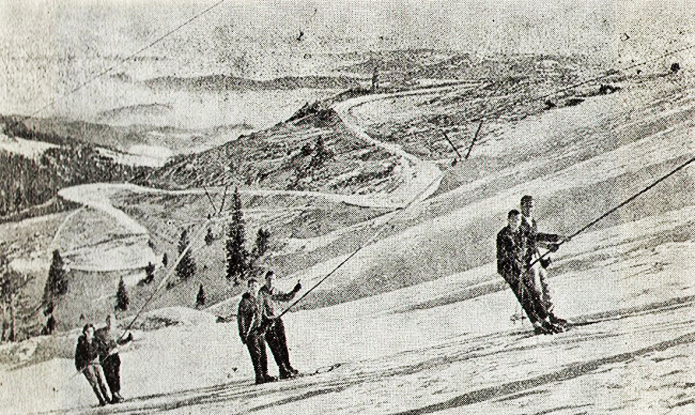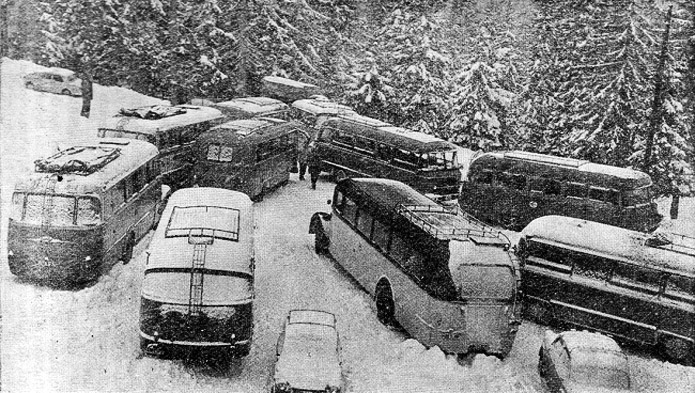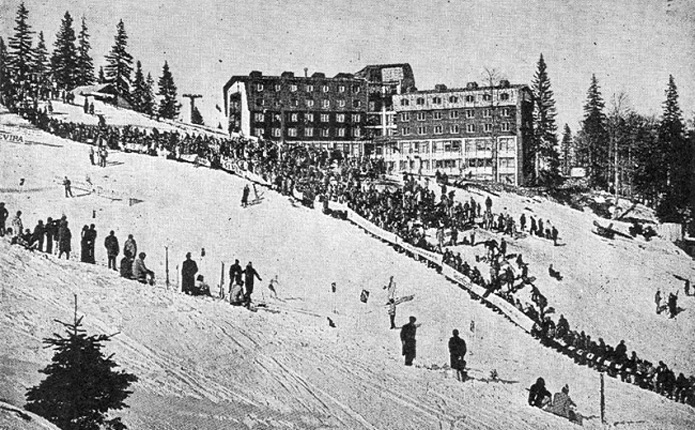The Austro-Hungarian period
The first building of a significantly large capacity on Jahorina mountain was a hunting lodge built in 1878 by the Austro-Hungarian bourgeoisie that used to hunt on Jahorina. An important step in the development of skiing was made on April the 4th in 1905 when it was founded in Sarajevo tourism, department of the Workers’ Tourist Society “Friends of Nature” as a branch of “Die Naturfreunde”. Winter hiking, mountain climbing using skis became one of the activities of this prosperous society, whose independent action was continued after the end of World War II. In 1912 a forest railway tracks from Pale (829 m) to Poljica (1530 m) on Jahorina mountain was built, providing the export of wood. The railroad is still leaned on the rail route Visegrad – Sarajevo, which was built from 1901 until 1904 commissioned by Emperor Franz Joseph. World War I interrupted the activities of the first fans of skiing. But with the end of the war, skiers continued with their activities.
The period after World War I
The first hunting lodge was burned down, and at that place a home “Romania” was build which had 60 beds that were also burned down in 1922. In 1923, the first fans of natural beauty come to Jahorina mountain and bring the first skis. In that year, the building of hotel “Sator” was made. The hotel has around 70 beds. Approaching the hotel is through forest. The first road trip straight to the top of Jahorina mountain was built along the railway in 1925 when general Djordje Tomic mobilized his troops and reserves for this purpose. This is a road route where Fertineli was pulling timber from Jahorina mountain until 1936. By the order of King Alexander, General Djordje Tomic builds the building of the Army, with 80 beds. In 1933. the first independent skiing organization called Ski Club Sarajevo was founded in Sarajevo. Until the war, 1941, the club was making significant efforts to improve it, at that time, unknown skiing sport, as well as competitions in all categories. In this period an international competition in the alpine skiing on Jahorina mountain was held. Although the constructed building offered comfortable accommodation, Jahorina mountain had curious visitors or groups who came there to enjoy the natural beauty of the mountains with low retention. That was until World War II when the existing buildings were destroyed and burned.

The period after World War II
After the Second World War (1941-1945) above listed burned buildings were renewed, and in the 1947 Jahorina mountain got its own electric light. An underground cable was built for electricity and telephone connections…and then begins construction of numerous hotels: • In 1950 the Union mountain lodge “Jahorina” was built, with 95 beds. • In 1955 the dome “Kosuta” was built, with 45 beds. • In 1959 the dome “Partizan” was built, with 120 beds. • In 1960 the villa “Bistrica” was built, with 44 beds. • In 1961 the dome “Mladost” was built, with 94 beds. • In 1975 the hotel “Jahorina” was built, a comfortable modern facility with 320 beds. In the same year, the dome “Kosuta” had become unusable, and the villa “Bistrica” was burned down in 1974. After World War II, the youth had built the road from Pale and Trebevic all the way to Rajska valley.

The first ski lift on Jahorina mountain was built and opened 29.11.1952. The starting lift station was located near hotel “Jahorina” at an altitude of 1660 m and it went to the top at altitude of 1885 m on Gola Jahorina. Cable length was 1050 m. It was a single-seater with a 102 seat, and capacity of 360 passengers per hour. The ride from the starting point to the top lasted 8 minutes. After the war there the Mountain-Ski organization was formed, which was more engaged in mountain climbing than skiing. Only in 1954 by forming an independent skiing organization called Sarajevo ski club, began an intensive work on improving skiing sport in Sarajevo. At the time besides the lifts there were ski tracks of length of 3660 m. Already, in 1957, a III Youth Championship of Alpine countries was held. The second lift was completed and opened in 1965. It was located at the starting station Poljice at an alt. of 1530 and it ended at an alt. of 1908 m next to “Zacarani dvorac” under “Ogorjelica”. The third lift was completed and opened 14.01.1971. It started at the starting station at hotel “Jahorina” of an alt. of 1660 m descended to the place of an alt.of 1329 m Ževnje – Vrhprača. It was a single-seater with 138 seat and capacity of 100 passengers per hour.
A ski lift was built at Rajska dolina, in 1972. This ski lift starts at starting station in Rajska dolina at 1655 m / alt. and goes to the top to 1855 m / alt. on Krvave lokve. Ski lift at “Partizan” dome was completed and opened in January 1976. And in 1976 started the construction of “circular single-line lift” with length of the route 1320 m, and it’s located west of the ski lift one slightly sloping plateau next to the curve at Ogorjelica. The plan was the construction of the ski lifts as well as the children’s lift – Pale Jahorina. Road Sarajevo – Jahorina was paved in 1971 and 1972, and in 1976 the road from Pale to Jahorina has been completed. In these seventies Jahorina mountain ski trails were verified by the World Skiing Federation – FIS, the downhill track with length of 3500m, and the altitude difference of 887 m. The start is at Gola Jahorina 1777 m / alt. and the end is in Vrhprača at 1090 m / alt. as well as the tracks for slalom and giant slalom. Every season on Jahorina mountain 4-5 significant competitions with an average participation of 100 competitors were organized. In 1974 Jahorina was the organizer of the World Youth and European skiing criteria, which at the time was a great affirmation of the mountain.

In 1975 in January, the European Cup for men and World Championship for women “Zlatna lisica” (Golden Fox) because in that year there was no snow in Maribor Pohorje. The European Cup competition on Jahorina was included in the FIS calendar in 1977. All this was a good introduction to the organization of the Olympic Games in Sarajevo in 1984. year.
(photo taken from the book Dr. Ljubo J. Mihić “Jahorina centar za rekreaciju”)

